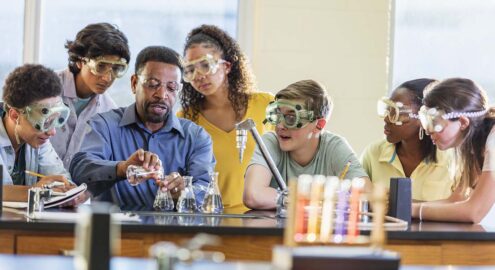Topic Overview
What is it?
For the past few decades, researchers have been asking the question, “What helps human beings thrive?” Given the complexity of our lives and the diversity of our backgrounds and environments, the answer to this question is not simple. While we all might prefer a magic solution—that one thing we know will work for everyone—instead, scientists have found that it’s a lifelong journey of choice, self-discovery, struggle, and connection. At the Greater Good Science Center, we call it the science of a meaningful life.
For educators who know that their responsibility towards students isn’t limited to academics, the science of mindfulness and well-being can help provide a starting point for teaching students the skills that will help them create flourishing lives filled with purpose and joy—for themselves, others, and their community.
While an agreed-upon definition of well-being doesn’t exist, in general well-being means “feeling and functioning well.” The field of Positive Psychology offers a framework for cultivating well-being that encompasses “positive emotion, engagement, positive relationships, a sense of meaning, accomplishment, and health.” Qualities and skills such as practicing gratitude or demonstrating compassion or forgiving your friend have been shown by research to contribute to our individual and collective well-being.
Mindfulness plays a key role in our well-being, because it helps put the skills of well-being into action. Mindfulness helps students deepen their awareness of the connection between their emotions, thoughts, and bodily sensations, making them better able to navigate their emotions, which then impacts things such as their behavior, stress levels, relationships, and ability to focus.
For example, when a pop quiz is announced, a student who is terrified of tests, rather than make an excuse to leave the classroom, “mindfully” notices that he’s starting to sweat and feel nauseous. This cues him to use his well-being skills to calm himself, such as thinking of working towards the larger purpose he has set for himself that requires certain academic knowledge.
Does science have a complete picture of how to impart well-being in our students? Not at all. The journey is actually very complex. As child development expert Marvin Berkowitz once said, “It’s rocket science.” But it’s a place to start, and it uses tools that educators can easily bring into their classrooms and schools.
Why is it important?
Student well-being and academic success are significantly related. When well-being is broken down into different qualities and skills, the connection becomes even more robust. For example:
Empathy creates a safer school culture.
- Increased empathy can decrease bullying and aggression among kids and make them kinder and more inclusive toward classmates.
Kindness and compassion benefit education.
- Preschoolers and elementary schoolers prompted to perform acts of kindness show increased well-being and social competence; in turn, prosocial (kind and helpful) peer interactions increase middle schoolers’ positive emotions and life satisfaction.
- Prosocial behavior in elementary school predicts higher academic achievement in middle school and high school.
Gratitude helps students do better in school.
- Gratitude makes students more satisfied with their school experiences, and, on average, more grateful students get better grades.
Students with purpose do better at school.
- Students with more purposeful goals find their schoolwork more meaningful, probably because they can see how it relates to their future aspirations, and tend to have higher academic achievement. A feeling of purpose in life even seems to protect students from potentially negative influences in their environments.
Awe fosters a sense of belonging.
- Some research suggests that spending time in nature can increase children’s sense of awe and their sense of belonging.
Courage helps students to navigate social and emotional challenges.
- Greater courage in adolescents is related to the use of more self-directed coping. Thus, in schools the practice of courage could help students better adapt to difficult situations and attain their personal and academic goals.
Humility might help students develop a sense of purpose.
- Adolescents with a strong sense of purpose also display great humility, while those low in purpose display low humility.
- Humility allows students to seek guidance from others, forming mentorship relationships that can help set students on track to achieve their goals in life.
Practices

Module 8.1 Purpose for Students

Module 8.2 Self-Compassion for Students

Module 8.3 Kindness and Compassion for Students

Module 8.4 Gratitude for Students

Module 8.5 Awe for Students

Module 8.6 Courage for Students

Module 8.7 Empathy for Students

Module 8.8 Mindfulness for Students

Module 8.9 Humility for Students

Module 8.10 Forgiveness for Students

Module 8.11 Hope for Students

Are you ready to build a kinder, happier school where everyone belongs? Join Greater Good Educators! Explore the science of well-being in a supportive community of educators from around the world. Registration is now open for the 2025-2026 school year!


